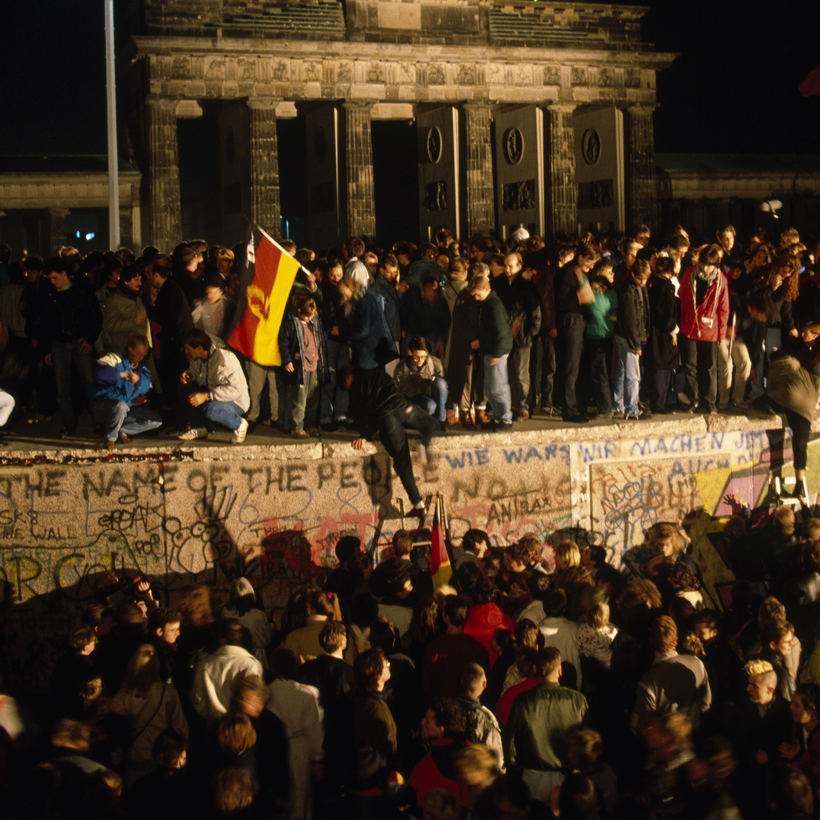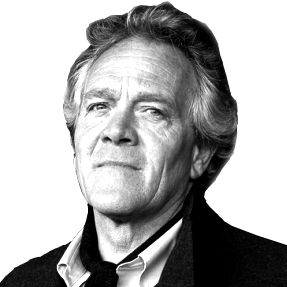The turboprop plane made a bumpy landing at Berlin Tempelhof late in the evening on Thursday, November 9, 1989. West Berlin’s airport was deserted. At the cab stand, I climbed into a Mercedes driven by an economics student named Rolfe, who spoke good English. He was listening to the car radio intently: something really big was happening. The Ossis—the East Germans—were massing at the crossing points in the Berlin Wall and walking into West Berlin. Incredibly, the Berlin Wall was open.
We headed north, to Checkpoint Charlie on Friedrichstrasse, with Rolfe translating the radio news. It was clear that events were moving fast in the East, yet it was unthinkable that the Wall would simply open without warning, without years of negotiation and some kind of treaty—and until we clambered out near Checkpoint Charlie and saw the crowds surging over the famous white line painted in the road at the checkpoint in 1961, we didn’t wholly believe it.
The Blink That Made History
It was the perfectly managed revolution. Not a life was lost, although on Monday, October 9, when a huge demonstration was planned in Leipzig, it looked as though the head of the Stasi secret police, Erich Mielke, would give the order to violently suppress the protestors, just as the Chinese had done in Tiananmen Square less than six months before. Shock troops were moved to the city and it was rumored that supplies of blood had been shipped to hospitals in readiness for mass casualties. But the regime blinked, and the candle-holding masses girdled their city and owned it for the night.

That was when the regime began to fall. It might have staggered on for much longer than it did had it not been for the epically mishandled announcement about travel regulations by the Berlin party boss Günter Schabowski, who appeared at the first live press conference with Western media during the crisis in East Berlin, at six p.m. on November 9—exactly one month after the Leipzig demonstration. It’s important to remember that Communist Party bosses had little experience of handling journalists who could ask them anything, and East Berliners tuned to their TVs and watched the conference live, and, later, the all-important replays of Schabowski’s regime-toppling blunder.
A bluff, self-important apparatchik, Schabowski had hurried from a meeting of the Central Committee to talk about the relaxation of the travel restrictions to the West, in the hope that this would defuse the demonstrations expected at the weekend. Accounts vary, but he either left with incomplete notes, was given a P.R. folder he had not read, or did not fully understand the new regulations. After nearly an hour, a journalist asked when the travel laws would come into force. Schabowski stumbled, then said, “As far as I know … immediately, without delay.”
“What Will Happen to the Berlin Wall Now?”
Reporters rushed out to tell the world what had happened (journalists didn’t possess laptops and cell phones in 1989 and the World Wide Web had only been conceived six months before). A minute or two later, a young British journalist working for The Daily Telegraph, Daniel Johnson, rose to ask one of the most important questions of any press conference in the 20th century: “Herr Schabowski, what will happen to the Berlin Wall now?”
No one had thought to mention the Wall, or make the obvious point that it would become redundant when people were allowed to cross to the West at will. Johnson shattered the spell with that question and Schabowski struggled to find an answer. As Johnson later wrote, “Schabowski could have seized the opportunity to make it clear that there was no question of opening the Wall that night. He could have explained what its rationale would be, now that people would no longer be shot for attempting to cross it. Instead, he hesitated. He stumbled over his words.”

It’s hard to grasp now, but the Wall that encircled the free enclave of West Berlin was a huge presence in all our minds, both East and West. Its dark aura had an almost Tolkienian power. Over 100 people had lost their lives trying to cross to the West, and in the 28 years of the Wall’s existence the two worlds that lived just a few hundred yards apart had come to believe that they were no more likely to be reconciled than light and darkness.
Whatever was happening in the East German protests that had been going on for about nine weeks by then, no politician, diplomat, spy, or activist would have dared to predict that people would take rock hammers and pickaxes to the Wall in front of the Brandenburg Gate and that within days the first slabs would be knocked over to create more crossing points.
No politician, diplomat, spy, or activist would have dared to predict that people would take rock hammers and pickaxes to the Wall in front of the Brandenburg Gate.
While in Berlin, we climbed onto the Wall at the Brandenburg Gate, sang and jeered at the Grepos—the Grenzpolizei, or border police—still in their thin summer uniforms, then went back to Checkpoint Charlie and walked against the flow of people into East Berlin. The Grepos had attempted to bar re-entry to anyone who crossed from East Germany—a vindictive move apparently designed to punish those who had left their children behind for the evening, but by the time we went along Friedrichstrasse, the authorities had given up checking papers and passports.
It was about 20 yards between the two border posts. Rolfe reminded me of Peter Fechter, the 18-year-old East Berliner who was shot in August 1962 in a dash for freedom just yards from Checkpoint Charlie. His partner escaped, but Peter lay there for an hour and bled to death. Only when you crossed the border did you see the scale of obstacle the escapee would have had to traverse. In most places, the Berlin Wall consisted of two walls, which faced east and west. Between them was no-man’s-land and all the prison-camp paraphernalia of watchtowers, searchlights, barbed wire, and trip-wire machine guns that fired along the line of the eastern wall.
Jubilant and Incredulous
We watched a steady stream of little Trabant cars, coughing fumes from their two-stroke engines, move toward the checkpoint. Even at that late hour, many Eastern Berliners were rushing to the West on foot, because, plainly, they thought the Wall would be sealed up before they’d had a chance to grab a beer and see what the West was really like. They were jubilant and incredulous.

The streets became silent as we went, and the lights were fewer, and of course there was none of the neon and nightlife of West Berlin. I remember it as though moving from the Technicolor of the West into a muffled world of black-and-white. The stores were closed, or shuttered, and the great public spaces only echoed with the odd hoot of celebration. It was like an abandoned movie lot—dismal and unreal—and, interestingly, there was no hint of the drama going on just a half mile away. It was the same in West Berlin: when eventually I left Rolfe and checked into a hotel 24 hours later, I found scores of men and women enjoying a late autumn beer festival, wearing traditional costume and chugging jars of ale as though nothing unusual had happened in their city.
I went east several times over the next few days, and I’m glad I did. Apart from seeing the drabness of the place for myself, on my return I experienced the rush of walking with the East Berliners into the bright, joyous, and free West. I have never seen the unguarded joy of childhood in so many adult faces, and this was what kept on giving you the sense that some kind of miracle had occurred.
I went east several times over the next few days.... I have never seen the unguarded joy of childhood in so many adult faces.
These days, as people take to the streets in their millions all over the world—recently there were vast protests in, among other countries, Lebanon, Chile, Hong Kong, and the United Kingdom—it’s worth considering the risk of protesting in the G.D.R., as well as the luck and tactical skill needed to topple the regime.
The revolution had its origins in the Monday night prayers for peace at the Nikolaikirche in the city of Leipzig—incidentally, the church where Johann Sebastian Bach served as music director in the 18th century. The Stasi watched these meetings closely as numbers swelled through September of that year, but they were at a loss to know what to do, because even for them it was awkward to arrest people who were merely praying for peace. And the protestors had another defense—the candle. If you were holding a candle on the streets, shielding its flame from the autumn breeze, it was obvious that you weren’t planning to hit someone, or pick up a rock and throw it.

Peace was their alibi and the candle their defense. Though the protests eventually became too big for all to carry candles, the protesters never appointed a leader, or created anything resembling a revolutionary committee, which meant the Stasi could not decapitate the movement by arresting those in charge. Bernd-Lutz Lange, a well-known performer, is quoted by the historian of the G.D.R., Mike Dennis: “There was no head of the revolution. The head was the Nikolaikirche and the body the center of the city. There was only one leadership: Monday, five P.M., St. Nicholas Church.”
We are apt to forget that the people in Leipzig marched without any realistic hope that within a few weeks the Berlin Wall would lose its power to terrify, and regimes would begin to tumble across Eastern Europe. I knew none of the background when I was in Berlin—of how courageous people praying for peace had won their country’s freedom, and how the simple prompting of a good journalist had exposed the frailty of the old-men’s regime. But it was plain that East Germans were sick of being fearful, and that in the final analysis anything is better than living with fear.
Henry Porter is a writer, a novelist, and an Editor at Large for AIR MAIL


